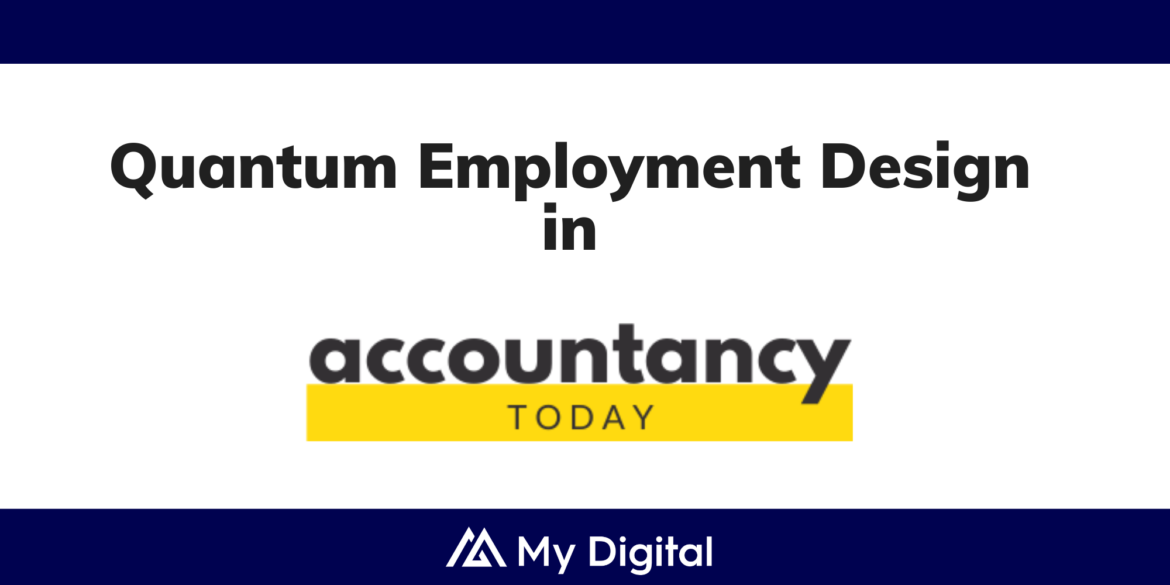ACCOUNTANCY TODAY: Why Quantum Employment Design is needed today
With Quantum Employment set to soar over the next five years, John Whelan, CEO of My Digital, discusses the importance of Quantum Employment Design.
The original article can be accessed here:
https://www.accountancytoday.co.uk/2020/10/19/qa-with-my-digital-why-quantum-employment-design-is-needed-today/
What key changes in the workforce have led to today’s Quantum Employment?
Today, permanent employment is on the wane with one in seven UK workers on flexible contracts. Across the pond, more than one in three Americans have freelanced in the last year. The shift to flexible employment is accelerating fast with workers completing small, incremental jobs across multiple companies day to day. We call this Quantum Employment.
The benefits of Quantum Employment are clear. Employers can respond to the changing market requirements with agility by building custom-made workforces rapidly when and where they are needed. As a result, employees on flexible contracts become ‘specialists’ who deliver specific skills on demand and can gain greater rewards for their work.
Have these changes been accelerated by the current pandemic?
The move to flexible contracts has been accelerated by COVID-19 as employers have had to make the difficult decision to furlough or let go of some in-house specialists, running the business on skeleton staff. It is not all bad news though, while many workers coming off furlough may face an uncertain future, many will be joining the ranks of the Quantum Employed.
It’s unlikely that permanent employment will return to many businesses after the current pandemic. Instead, employers will work with specialised consultants and the Quantum Employed to complete specific tasks for the business.
What does Sunak’s Job Support Scheme mean for today’s Quantum Employment?
Sunak’s Job Support Scheme is a sign of the times as businesses will only maintain ‘viable’ jobs. This means when the scheme comes into play in November, there will be mass redundancies which will create a highly competitive job market and more workers will choose flexible contracts.
These flexible work options, often for more than one employer per week, is a trend which is set to make the UK economy more competitive and resilient to future changes. The ability of both employers and workers to divide their work efforts into smaller and smaller tasks, or quanta, is essential to the UK’s economic recovery.
What challenges does Quantum Employment present for businesses?
The Quantum Employed need to be paid and taxed in a timely manner if they are to function for the benefit of all stakeholders. When working with one or two flexible workers, this task is easy enough to handle. However, in Quantum Employment, businesses will work with a variety of flexible workers from day to day, constantly changing and ultimately creating challenges for employers as payments and taxes become muddled.
The problems and complexities rise with scale. In the modern workplace, all parties need real-time information, from ID checks to timesheets, to cash matching and accounting ledgers. Yet today, many employers use technology which predates digital employment and is just not up to the task. Their onpremise solutions slow everything down and lack the transparency needed – meaning it takes too long and too many people to complete payroll.
How does My Digital aim to work with businesses to solve these challenges?
My Digital is a pioneer in Quantum Employment Design (QED) and the leading SaaS supplier for tomorrow’s digital workforce. It works with businesses to provide a QED software suite which gives teams transparency on payments and speeds up the core processes needed to pay and tax flexible workers accurately and efficiently.
The QED software suite understands and adapts to process changes. It starts by providing an enhanced onboarding experience for individuals. It automates timesheets, invoices and bank matching across, and all the way through to, payslips and tax remittances. It does all this without bogging down an in house IT team or buying fast depreciating computers and their tiresome updates.
What does Quantum Employment Design (QED) mean, specifically?
Quantum refers to the smallest measurement possible. Quantum Employment describes the temporary labour workforce which can complete multiple small increments of work for different employers. Quantum Employment Design (QED) means to cope with the smallest element of employment – minutes on a timesheet.
QED removes the need for manual consolidation of flexible workers payments and tax. It also removes the need for on-premise solutions and can be deployed wherever the team is and whenever it is needed. It exists to serve the needs of the many and the few when it comes to the modern workforce.
Why is Quantum Employment Design (QED) needed today?
At the end of October, the UK will see an inevitable rise in unemployment as the furlough scheme comes to an end and the Job Support Scheme takes its place. Now more than ever, workers will choose to move onto flexible contracts and businesses will choose to work with the Quantum Employed. Jobs for life are history.
At this critical time, Quantum Employment Design (QED) is needed to ensure fast and accurate cash flow for both businesses and flexible workers. QED provides transparency on payments and speeds up the core business processes specifically for Quantum Employment.
How do you see Quantum Employment progressing over the next five years?
In the UK today, workers on flexible contracts have risen by 25% over the past two decades and show no signs of slowing. Quantum Employment is set to soar over the next five years as more businesses work with specialists for small, individual projects, rather than working with full-time employees. Each of these businesses and contractors will rely on Quantum Employment Design (QED).
QED has been created for tomorrow’s Quantum Employment world of work.
